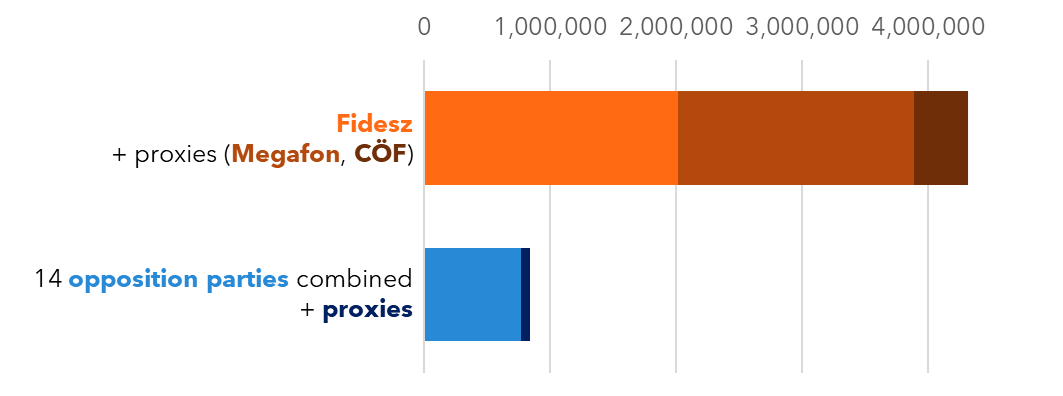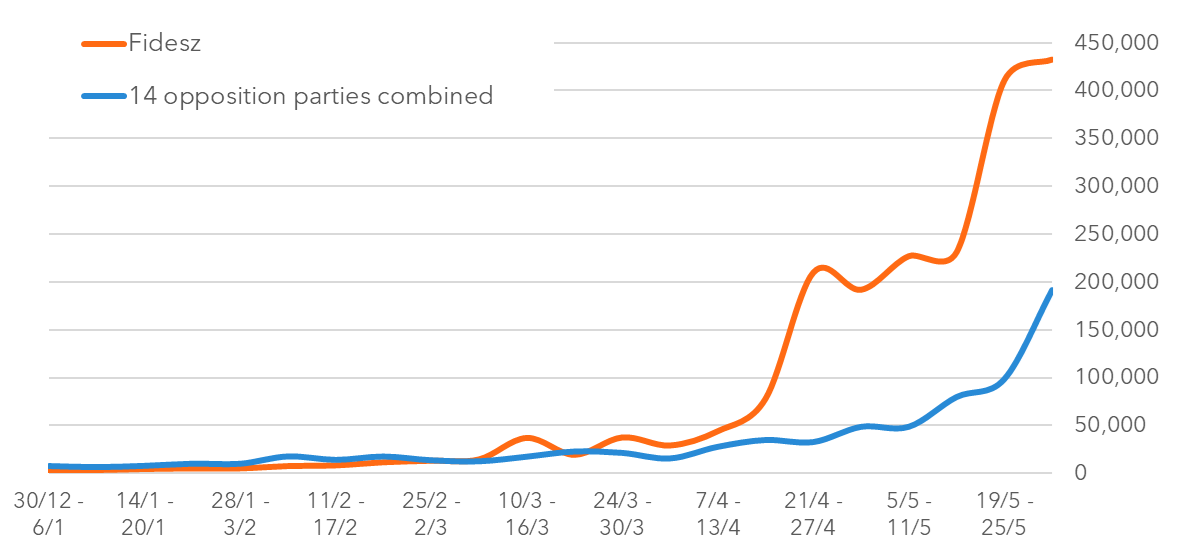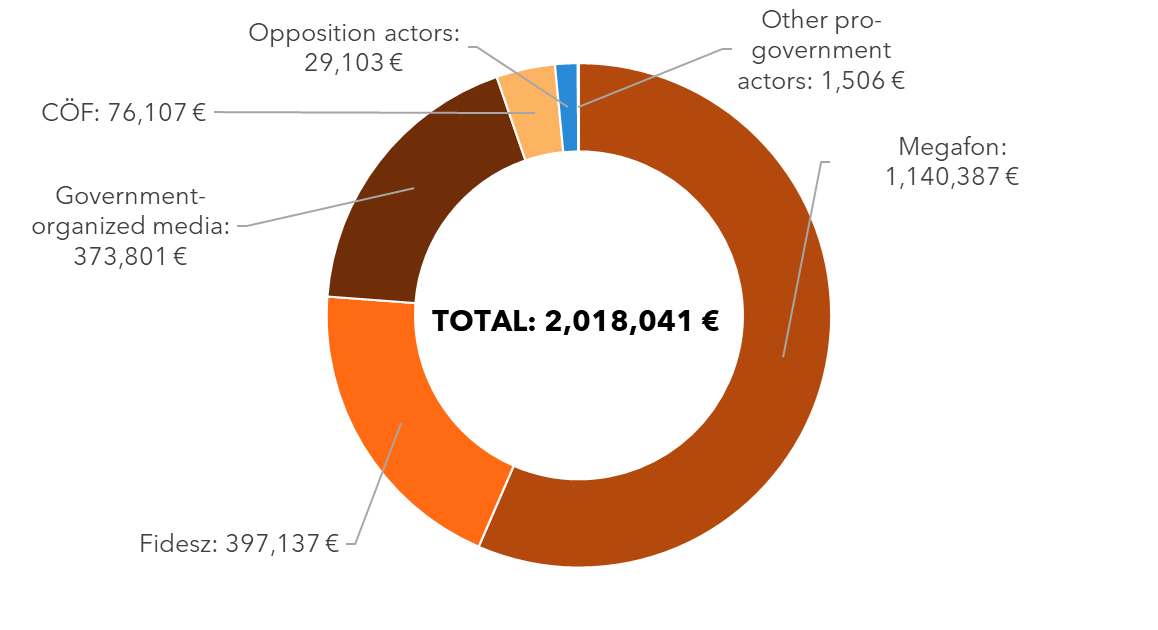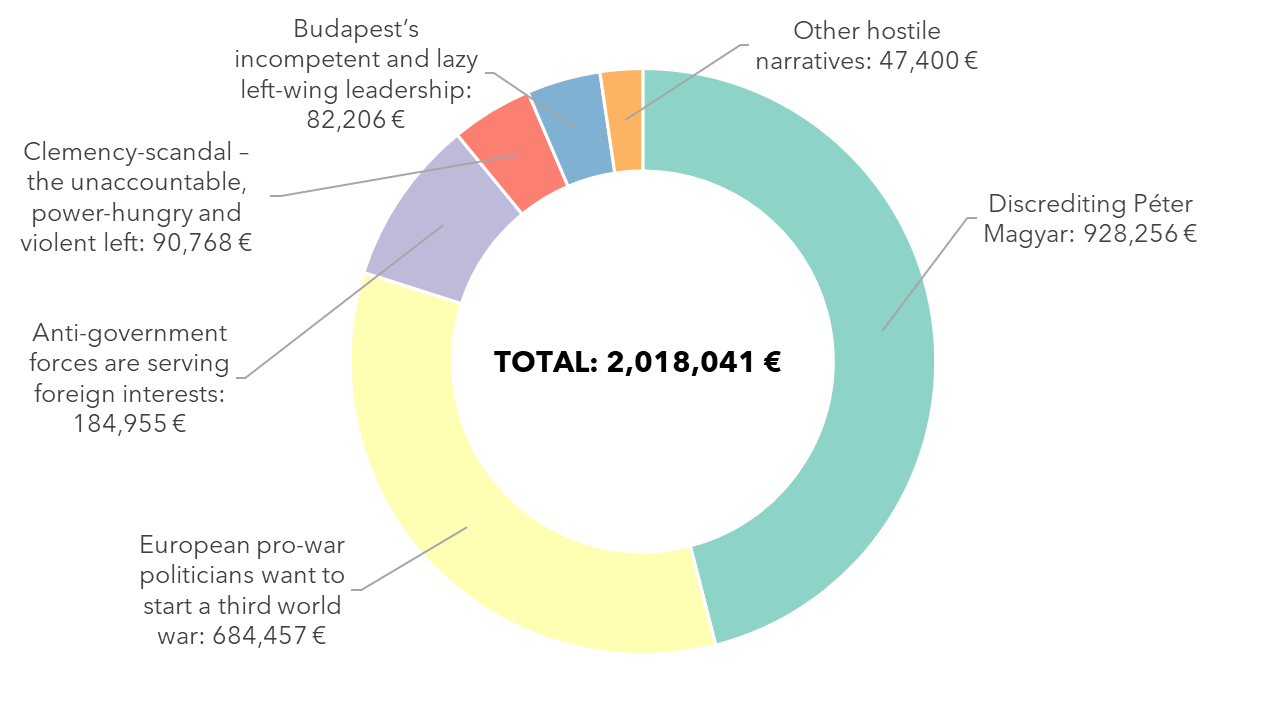Fidesz & Co. flood social media with anti-Western hostile disinformation in Hungary’s election campaign, reaching EU spending records
It is almost common knowledge that elections in Hungary are characterized by a lack of a level playing field, as noted in the final report of the OSCE-ODIHR Election Observation Mission for the 2022 parliamentary elections. The results of our investigation, funded by the European Media and Information Fund, into political advertising spending and the promotion of hostile disinformation narratives on social media during the 2024 election campaign in Hungary have just confirmed this. The current analysis follows our previous report published at the end of April, and covers the period from 31 December 2023 to 1 June 2024.
This analysis is also available as a .pdf file here.
Key findings
- Political ad spending in Hungary is highly asymmetric. While the pro-government camp spent €4.3 million on Meta and Google ads, all 14 opposition parties and their associated media spent less than a fifth of that, €839,000.
- Fidesz and its politicians alone spent €2.0 million, 2.6 times more than all 14 opposition parties combined, which totaled €764,558.
- Fidesz’s campaign has been heavily supported by third parties, mainly two GONGOs, Megafon and Civil Union Forum, which spent an additional €2.3 million. In contrast, opposition proxies spent a total of €74,530.
- Government-organized media also played their part in the campaign, spending €1.8 million on advertising, although not exclusively on political issues. In contrast, independent media spent only €46,648.
- The level of online political advertising spending in Hungary is outstanding even by European standards. Fidesz was the biggest advertiser on Google in the EU this year, paying for six of the 10 most promoted videos. On Meta, Megafon ranked 10th and Fidesz 12th in the ranking of EU countries based on political ad spending data between 14 April and 13 May.
- Fidesz and its proxies are the main purveyors of hostile disinformation narratives in Hungary, responsible for 98.6% of the total €2.0 million spent on promoting such narratives. All opposition parties and their partisan media share the remaining 1.4%.
- The data confirm that Fidesz largely outsources its negative campaigning to third parties: while Fidesz's proxies spent €1.6 million promoting narratives hostile to Fidesz’s political opponents, Fidesz spent only €397,137 directly.
- The most promoted hostile narrative in the whole period from 4 February to 1 June targeted the newly emerged opposition hopeful Péter Magyar, accounting for 46% of total spending on promoting such narratives.
- The second most promoted hostile narrative, accounting for 34% of total spending, concerns the war in Ukraine, suggesting that “European pro-war politicians and their Hungarian servants want to start World War III”. This narrative gradually grew in importance as the elections approached, overtaking and partly absorbing all other narratives in the final weeks.
- The third most promoted hostile narrative, accounting for 9% of total spending, is about anti-government forces allegedly serving foreign interests.
- The degree of social media dominance revealed by our investigation makes the political contest in Hungary truly one-sided and points to the problem of massive state-sponsored information manipulation in the EU and NATO.
- The dominance of anti-Western, pro-Kremlin hostile disinformation narratives promoted by the Fidesz camp is consistent with the findings of our recent study showing that Fidesz MEPs are “soft defenders” of Russia and other authoritarian regimes in the European Parliament, engaging in pro-Kremlin discourse while deliberately abstaining from voting due to political and reputational risks. Moreover, after Russia’s full-scale invasion of Ukraine, Fidesz MEPs increasingly abstained from voting on Russia-related issues and even began to vote against resolutions condemning the Kremlin.
In partnership with fact-checking site Lakmusz and media think-tank Mertek Media Monitor, Political Capital Institute has been monitoring political advertising on Meta (Facebook and Instagram) and Google (YouTube) since early 2024, tracking spending on ads, advertisers and narratives. We have focused on narratives that go beyond disinformation and fit the definition of what is known in the literature as ‘hostile narratives’. In our methodology hostile narratives are characterized as 1.) the deliberate distortion of facts via narration and manipulative storytelling; 2.) the exaggeration of existing fears and perceived threats; 3.) the portrayal of socio-political actors and opponents as enemies.
The report's first section examines political advertising on social media, detailing spending by various actors. The second and third sections analyze the promotion of hostile narratives, identifying promoters, widely circulated narratives, and terms used to depict enemies.
1. Political advertising on social media in Hungary’s election campaign
1.1. Fidesz and its proxies vs. the opposition and its proxies
The current election campaign has once again revealed a huge asymmetry in political ad spending by political camps in Hungary. While the pro-Fidesz camp spent €4.3 million on Meta and Google ads from the beginning of this year until 1 June, all 14 opposition parties and their associated media spent less than a fifth of that, €839,000 (see Figure 1).
Fidesz and its politicians alone spent €2.0 million, which is 2.6 times more than the combined spending of all 14 opposition parties, which amounted to €764,558. However, Fidesz’s campaign has been heavily supported by its proxy organizations, referred to as ‘third parties’ in the 2022 report of the OSCE-ODIHR Election Observation Mission, which seemingly independently promoted the ruling party’s messages. Two government-organized actors played a major role in the campaign. Megafon, an organization that trains, coordinates, finances, and promotes pro-government social media ’influencers’, spent almost €1.9 million, and the Civil Union Forum (CÖF), a government-organized NGO (GONGO) to which Fidesz usually outsources its negative campaigning, spent another €430,568. The two proxies together spent €2.3 million, 3 times more than all opposition parties combined. In contrast, opposition proxies spent a total of €74,530.
The level of online political advertising spending in Hungary is outstanding not only in the national context, but also by European standards. Not only did Hungary have the highest spending on Meta in the EU relative to population size, but according to calculations by our partner Lakmusz, Megafon ranked 10th and Fidesz 12th in the ranking of EU countries based on political ad spending data between 14 April and 13 May. Fidesz was also the biggest advertiser on Google in the EU this year, spending €481,000 on ads up to 6 June, according to data from the Google Ads Transparency Center. Six of the 10 most promoted videos in the EU were paid for by Fidesz, as were the 11th and 15th most promoted videos.
Figure 1: Political ad spend on Facebook and Google (in euros, between 31 December 2023 and 1 June 2024, source: weekly reports from Meta Ad Library and Google Ads Transparency Center, for HUF-EUR conversion we used the official rate on 6/6/2024)

Spending on political advertising began to soar in early April, widening the gap between Fidesz and the opposition parties (see Figure 2 below). In the last two months of the campaign, between 7 April and 1 June, the pro-Fidesz camp spent €3.3 million, while the opposition camp spent €627,147. Thus, even without proxies, the difference in available resources between the ruling party and the opposition is spectacular. This gives Fidesz a significant advantage in reaching potential voters – in line with the assessment of the OSCE-ODIHR Election Observation Mission in 2022, which found a huge asymmetry in the access to the public arena between the government side and its opponents.
Figure 2: Weekly ad spending of Fidesz and the 14 opposition parties combined on Facebook and Google (in euros, aggregated data based on party affiliation of politicians, candidates and affiliates running ads, source: weekly reports from Meta Ad Library and Google Ads Transparency Center, for HUF-EUR conversion we used the official rate on 6/6/2024)

1.2. Pro-government media vs. independent media
The ruling Fidesz party’s campaign has been supported not only by GONGOs, but also by the highly centralized and controlled pro-government media empire, which spent €1.8 million in the first five months of the year to advertise its content, although not exclusively on political issues. Nevertheless, government-organized media are often involved in spreading Fidesz messages, which is clearly visible in Figure 3: the peaks highlight periods when they ran advertising campaigns promoting government narratives. In contrast, media independent of the government and political parties spent only 3% of this, or €46,648, in the same period.
Pro-government media spending on Google is also outstanding by European comparison. In the ranking where Fidesz is the biggest European advertiser, Mediaworks, which runs many of the government-organized media outlets, is in sixth place with €338,000, even ahead of the EPP group in the European Parliament.
Figure 3: Weekly ad spending of pro-government media on Facebook and Google (in euros, source: weekly reports from Meta Ad Library and Google Ads Transparency Center, for HUF-EUR conversion we used the official rate on 6/6/2024)

2. The main promoters of hostile narratives
Fidesz and its satellite organizations are the main – and almost sole – purveyors of hostile disinformation narratives in Hungary, responsible for 98.6% of the total €2.0 million spent on promoting such narratives, while all opposition parties and their partisan media were responsible for only the remaining 1.4% (see Figure 4).
As shown above, Fidesz uses proxies such as GONGOs and government-organized media to amplify its messages. However, the role of these organizations becomes particularly clear when looking at the promotion of hostile messages. The data show that Fidesz largely outsources its negative campaigning to third parties: while Fidesz’s proxies spent €1.6 million promoting narratives hostile to Fidesz's political opponents, Fidesz spent only €397,137 directly.
Fidesz’s covert communication efforts were led by Megafon’s pro-government ’influencers’, who spent at least €1.1 million on videos spreading hostile narratives targeting all real and imagined opponents of the government. This accounted for over half (56%) of all spending.
Government-organized media spent a total of at least €373,801 on hostile narratives, making them the third largest promoter of such content.
While CÖF’s contribution to the campaign with its short videos targeting opposition politicians was crucial at certain times, overall it has only played a limited role, spending only at least €76,107 to promote hostile narratives. However, this is still 2.6 times more than the opposition parties and their proxies spent on such content.
Anti-government hostile narratives are also present but remain almost below the surface. All opposition parties, mainly former Prime Minister Ferenc Gyurcsány’s Democratic Coalition (DK) and its proxies, spent a total of €29,103 on advertising content with hostile narratives.
Figure 4: Ad spending on hostile narratives on Facebook, by advertiser (in euros, based on individual ads active between 4 February and 1 June 2024, downloaded via Meta Ad Library API and categorized by Political Capital, for HUF-EUR conversion we used the official rate on 6/6/2024)

3. The most promoted hostile narratives and terms
Figure 5: Ad spend on hostile narratives on Facebook, by narrative (in euros, based on individual ads active between 4 February and 1 June 2024, downloaded via Meta Ad Library API and categorized by Political Capital, for HUF-EUR conversion we used the official rate on 6/6/2024)

3.1. Discrediting Péter Magyar
The most promoted hostile narrative in the whole period from 4 February to 1 June targeted the newly emerged opposition hopeful Péter Magyar, who entered the political arena after the clemency scandal erupted in early February. Hostile narratives aimed at discrediting him alone were promoted for a total of at least €928,256 or 46% of the total spending. However, as the elections approached, hostile narratives against Péter Magyar faded somewhat and were partly subsumed into hostile narratives about the war. While the vast majority of the above amount was spent by Fidesz's proxies, a small part was spent by hyperpartisan media outlets close to the opposition party DK.
The discrediting campaign by pro-government actors, particularly the government-organized media and Megafon ‘influencers’, has promoted multiple narratives about Péter Magyar, accusing him of being a “power-hungry” person, who had become the “new leftist messiah”, to serve the interests of the “American left owned by the empire of George Soros”. After his ex-wife revealed details of their failed marriage, claiming that Magyar had abused her, the smear campaign kicked into high gear, and Magyar was regularly branded as a personality-disordered, violent, pro-war man who is causing people to riot (see the hostile terms below).
The intense Russian-style smear campaign against Magyar has been aimed at protecting Fidesz’s core voter base and neutralizing the political risk of Magyar’s rise, by trying to discredit him both personally and politically.
Examples of hostile terms used in the narrative: Clown Peter; the left’s new messiah; leftist lie masquerade; left-wing star-makers and messiah-carvers; liberal-commies; life-threatening mental disorder; Iombic messiah; metropolitan liberal messiah; narcissistic footballer’s wife; new globalist investment; petty blackmailer; Psycho Péter; power-hungry abuser; project of the American left; the left’s endless cesspool; the nightmare of psychologists; wife terrorizing, wiretapping, family humiliating, leftist little bully; libtard; Soros-infected politician.
Background: Who is Péter Magyar?
After the clemency scandal and the resignation of both President Katalin Novák and former Justice Minister Judit Varga, the ex-husband of the latter, Péter Magyar stepped into the political scene. His accusations against the government, the prime minister, and several ministers are powerful mainly because he was a member of the regime’s inner circle and held senior positions in state-owned companies. As he grabbed the attention of the public, rallying tens of thousands of people on multiple occasions, he decided to start a party challenging both the governing Fidesz and all opposition parties. According to some recent polls, his party has around 26 percent support among active voters with party preferences.
3.2. “European pro-war politicians and their Hungarian servants want to start World War III”
The second most promoted hostile narrative overall is that “European pro-war politicians and their Hungarian servants want to start World War III”. Pro-government actors spent €684,457, or around 34% of the total, on attacking the so-called „European pro-war politicians” and their Hungarian ‘servants’ who are contrasted with the government’s peace narrative. This narrative gradually grew in importance as the elections approached, overtaking all other narratives in the final weeks. This can be seen from the fact that from 4 February to 6 April, only 18% of the total amount spent on hostile narratives was devoted to this narrative, compared to 34% in the whole period up to 1 June.
Pro-government actors from the prime minister to political talking heads have manipulatively edited excerpts of speeches of European politicians, accusing them of being “warmongers”, in the service of the “globalist war lobby” who want to “enlist man and women across Europe to send them to die in Ukraine”. The World War III narrative reinforces the false message that this year’s election is a choice between war and peace. The argument is that the ‘pro-war left’ and most Western countries want to drag Europe into the Russian-Ukrainian war by sending weapons and troops to help Ukraine. On the other hand, the right, led by Fidesz, is pro-peace, and it alone wants to end the military conflict by advocating for a ceasefire and peace talks. The European politicians targeted by these narratives include Ursula von der Leyen, Emmanuel Macron, Donald Tusk, Olaf Scholz, Manfred Weber, Jens Stoltenberg, and several ministers of the German and Polish governments. Most of them are simply labeled as “leftist”, even though many of them belong to right-wing parties.
This narrative is built upon years of pro-Kremlin disinformation campaign of Fidesz and the government-organized media in Hungary, spreading conspiracy theories about Ukraine, and the West’s role in the conflict, often directly borrowing from Russian strategic narratives.
Examples of hostile terms used in the narrative: Brussels bullshit train; Brussels imperial army; Brussel war council/center; European politicians drunk on war psychosis; fantasies of nuclear war; global beepers; globalist left-wing war hawks; generals of the Soros-plan in Brussels; Polish leader burning with battle fever; pro-war Brussels leaders; pro-war governments; pro-war censorship; Soros-bitches; Soros-shuffle mix; Sorosist Polish minister; the left has been completely taken over by the psychosis of war; the Polish government that aggressively took power; the war train has no brakes; war profiteers; war-hungry globalists; wartime insanity; Zelensky's hysterical demands.
3.3. “Anti-government forces serve foreign interests”
Third on the list of spending on hostile narratives is the narrative that “anti-government forces serve foreign interests”, which was promoted for €184,955, or 9% of the total. While the importance of this narrative seems to have diminished as the elections approached, as evidenced by the fact that its share of total spending was 16% in the period from 4 February to 6 April, compared to 9% in the whole period up to 1 June, it has mainly merged with the third world war narrative.
According to this narrative, the opposition parties and independent media are foreign agents funded by George Soros and the so-called “international globalist war, migration, and gender lobby” to serve their interests in Hungary. They are accused of “being in the pockets of the globalists” to “drag Hungary into the Russo-Ukrainian war, allow illegal immigrants into the country, and spread gender propaganda to poison children’s minds”. The labels “dollar left”, “dollar media” and “dollar celebrity”, built up over the last two years, are used by Fidesz, its proxies and media as synonyms for foreign agents to stigmatize any anti-government or independent organization or individual – following the Russian model.
Examples of hostile terms used in the narrative: betrayed the entire nation; dollar army; dollar celebrities; dollar left; dollar media; dollar pimps; dollar workers; Dollar Daddy of the US Embassy; fooling the Hungarians for a few bucks; globalist masters of the left; Hungarian-poisoning Soros-dollars; LGBTQ brainwashing; leftist scheming Brussels; humble servants of Brussels; pro-war left-wing politician bought with dollars; sold out the country for dollars; Soros empire; traitors; treasonous politician; violent woke propaganda; war-gender-migration propaganda.
3.4. Clemency scandal: the pro-government narrative about the “unaccountable, power-hungry and violent left”
The pro-government messages to reframe the clemency scandal are the fourth most promoted hostile narrative with spending of €. This narrative attacks opposition politicians and the independent media that exposed the scandal as allegedly “irresponsible”, “power-hungry” and “violent”.
The narrative is that then president Katalin Novák and former justice minister Judit Varga took political responsibility by resigning and admitting “failure”, authentically representing the values of the right-wing community, while in contrast, opposition politicians (uniformly labelled as left-wing) never take responsibility for their actions and sins. The government-organized media has also accused opposition politicians of using the issue of child protection for their political gain, and that they are a group of “unaccountable”, “power-hungry” and “violent” individuals, who will use any means to gain power.
Examples of hostile terms used in the narrative: bearded women; crazy woke-people; crimes against the nation; hypocritical and two-faced left; Sorosists comrades; the jackals of our public life; the left’s gender-fever-induced insanity; the left-without-consequences; trans-lobby; violent antifas; violent gender-propaganda.
Background: What is the clemency scandal?
The so-called clemency scandal, resulting from a presidential pardon granted to an individual who had been convicted of covering up a child sexual abuse case, and who had close ties to senior figures in the ruling party, has shaken the government in February 2024. Following the subsequent resignation of President Katalin Novák, and former justice minister Judit Varga, who were directly involved in granting the pardon, the ruling party and its media immediately tried to reframe the issue.
3.5. Budapest’s incompetent and lazy left-wing leadership
Parallel to the European Parliament elections, local elections are held across the country on 9 June. Hungary’s capital city Budapest will be a key battleground for the opposition and Fidesz meaning a heightened campaign started against the incumbent mayor of Budapest, Gergely Karácsony. Alexandra Szentkirályi, Fidesz's candidate for mayor of Budapest until she withdrew from the race on 7 June, and Megafone’s ‘influencers’ spent €82,206 (4%) to accuse Gergely Karácsony, mayor of Budapest of being pro-war, corrupt and incompetent, who has been busy "robbing the City Hall" instead of solving the city's problems as a "puppet" of Ferenc Gyurcsány, leader of the DK party and Fidesz’s decades-long archenemy. In this campaign, a cartoon video of Karácsony appearing as the baby of the Gyurcsány family was a qualitative leap in the negative and hostile portrayal of the mayor.
Examples of hostile terms used in the narrative: Baby Gyurcsány; Bankruptcy Mayor; Budapest is the prisoner of the dollar left; Ference Gyurcsány is a disease that infects Budapest; puppet in the mayor's chair; pro-war dollar left Gyurcsány puppet; Mr. Wimp.
3.6. Other hostile narratives
Other hostile narratives on different topics accounted for EUR 47,400 spent by several different actors.
We identified dozens of other ads that more or less fit the concept of hostile narratives but reached far fewer people because of the lower spending on them. A prime example was the opposition’s narrative attacking the Orbán government over the clemency scandal, labelling prominent government politicians, including former President Novák, and Prime Minister Viktor Orbán “pedophile saviours” for their role in the decision. Another branch included pro-Kremlin and anti-Ukrainian narratives related to the Russo-Ukrainian war and Sweden’s NATO accession, spread by government-controlled media and the far-right Mi Hazánk party. A prominent example was the alleged plan of the Ukrainian government to occupy Hungary if it lost the war against Russia. This story was quickly debunked by our fact-checking partner Lakmusz. Mi Hazánk has also promoted several conspiracy theories about total digital surveillance by companies and the state, exaggerating the risks of artificial intelligence and online payment solutions.
The opposition DK party has also attacked the new Fidesz-nominated president of the republic, Tamás Sulyok, with his father’s “full Nazi” past and that he was part of a “land mafia” that sold Hungarian farmland to foreign buyers in the 1990s, reflecting to two recent scandals involving the president. Klára Dobrev, the leader of DK’s European Parliament list, has also described the Chinese president’s visit to Hungary as the “arrival of Chinese colonial ships”. In a similar vein, another opposition party, the LMP-Greens, has spread a hostile narrative about battery manufacturing plants “colonizing” Hungary.
A consortium led by Political Capital and including Lakmusz and Mérték Médiaelemző Műhely has won a €143,000 grant from the European Media and Information Fund (EMIF) for the implementation of the project on electoral disinformation. Any content supported by the EMIF is the sole responsibility of the author(s) and does not necessarily reflect the views of the EMIF or of the Fund's partners, the Calouste Gulbenkian Foundation and the European University Institute.


